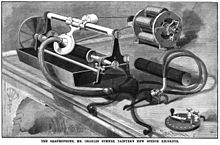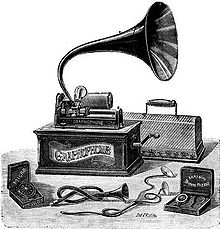Graphophone

A Graphophone , in English Graphophone , is a further development of the phonograph invented by Thomas Edison by the chemist Chichester Alexander Bell and the engineer Charles Sumner Tainter , for which they were granted the patent on May 4, 1886.
history
prehistory
After Edison had presented his invention of the phonograph to the world public, along with the beginning of commercialization by representatives who equipped with the new speaking machine , made public presentations on all kinds of occasions for a fee, Edison's interest in his invention increasingly flattened as Edison grew Coping improvements seemed immense. So he decided to have a sophisticated phonograph for the next generation, with which, for example, the problems with the s-sounds and the low volume would be resolved. Furthermore, Edison saw the use of the phonograph more as a dictation machine than as a device for reproducing music, as he wrote in an article consisting of ten points of the improvements to be made, the magazine North American Review and therefore estimated the profit prospects as little in proportion to necessary effort. Ultimately, Edison first turned to other financially more promising developments.
Graphophone
The further development of the Edison phonograph took place in the Volta Laboratory founded by Alexander Graham Bell in 1881 , which is located in Georgetown , Washington, DC . - The United States was funded by the $ 10,000, 50,000 Franc Volta Prize he received from the French Académie des Sciences for the invention of the telephone. His cousin Chichester Bell and Charles Summer Tainter, who is related to Alexander Graham Bell, were involved in the continuation of the technical development of the phonograph. Both inventors were granted a patent for the improved version of the phonograph, which they called the Graphophon, on May 4, 1886.
The essential further development step in this context was the replacement of the tin foil used by Edison as a recording medium for the sound signals, stretched on a rotating cylinder, by a cardboard tube covered with wax, which led to a considerable improvement in the sound properties. While the tin foil phonograph did not previously write the sound signals completely into the sound carrier, but often only as a sequence of dots and oval depressions, the graphophone's stylus now engraved the mechanically converted sound waves, similar to the cutting process on a lathe, continuously and without interruption in the phonograph cylinder used . Further improvements that resulted from the use of sound carriers with a wax coating were, on the one hand, the improved durability of the sound media with regard to wear and tear during playback and, on the other hand, the reduction of annoying background noises, such as scratching by the recording stylus.
It should be noted that the first graphophones were initially quite simple, not fully developed devices, which were only gradually perfected in the following years through their commercialization. The first models, like the phonographs that were offered and used at the same time, had a hand crank drive, a funnel for recording sound waves and a hearing tube that was used to play back recordings. Later achievements such as spring or weight drives were not yet integrated into the devices.
Commercialization
With the completion of the development phase and after the granting of various patents relating to the Graphophone, Alexander Graham Bell, Chichester Bell and Charles Sumner Tainter, as founders of the Volta Laboratory Association, tried to reach an agreement with Edison and his business partner Edward H. Johnson and to further commercialize it of the devices. For this purpose, Tainter, knowing that the further developments of the graphophone were based on the findings of Edison and his first phonograph, traveled to New York for two months with the aim of arousing interest in a collaboration. The offer made here included, on the one hand, the recognition of Edison as the original inventor and, on the other hand, the assumption of all further costs for future experiments. In return, there was a requirement to share half of the possible profits. Edison declined this offer because he feared that his invention would be stolen and snatched from him. He now turned back to his phonograph and began to optimize it as well and bring it to more intensive commercial use.
Volta Graphophone Co.
After the failure of the experiment, Edison and Johnson integrate as well as the continuation of development activities accompanied further with the construction Graphophone decided the members of the Volta Laboratory is a successor company to Volta Laboratory Association named Volta Graphophone Company (Volta Graphophone Co.) to set up, whose task should exist to market the inventions made and the patents resulting from them.
American Graphophone Co.
With the agreement between the businessmen James O. Clephane, Andrew Dewine, John H. White and the later first general manager Edward D. Easton on the one hand and the Volta Graphophone Comany on the other hand to manufacture dictation machines under the granting of the corresponding license and to offer them for sale, on 28. The American Graphophone Company (American Graphophone Co.) was founded on March 8 , 1887 , with manufacturing facilities located in Bridgeport , Connecticut . Shortly afterwards, the US entrepreneur Jesse H. Lippincott , who has a share of 200,000 US dollars in this, receives the marketing rights to the graphophones, including the associated accessories, which are specially tailored for use in a business environment. In addition, Lippincott agreed to accept 5000 roller players annually.
North American Phonograph Company
Lippincott, now in possession of the exclusive distribution rights for the Graphophone, got in touch with Edison to negotiate the commercial use of the phonograph, with the ulterior motive of clearing the looming costly legal battle between the Edison Phonograph Company and the American Graphophon Company to use profitably. After considering all options, Edison and his agent decided to give Lippincott the share capital of the Edison Phonograph Company for US $ 500,000 and consequently the patents for the phonograph including the associated distribution rights. They also allowed Lippincott to set up a new business called the North American Phonograph Company , which began renting out dictation machines right away. However, the company was denied success, so that bankruptcy occurred just two years after it was founded in 1890.
Model overview (selection)
- Mignon
- Adler-Graphophon BX
- Columbia-Graphophon AT
- Columbia Graphophon AZ
- Universal graphophone
- Grand Type
- Columbia double graphophone
- Graphophone "The Twentieth Century"
swell
literature
- Herbert Jüttemann : Phonographen und Grammophone , 4th edition, Funk-Verlag Hein, Dessau 2007, ISBN 978-3939197171 .
- Hoffmann, Frank W. & Ferstler, Howard: Encyclopedia of Recorded Sound, Routledge, London 2005, ISBN 978-0415938358 .
- Peter Tschmuck: Creativity and Innovation in the Music Industry , 2nd edition, Springer, Heidelberg, New York, Dordrecht, London 2012, ISBN 978-3642284298 .
Individual evidence
- ↑ Recording and reproducing speech and other sounds. May 4, 1886, accessed June 3, 2017 .
Web links
- Charles Summer Trainter and the Graphophone , Audio Engineering Society (English) , accessed on June 3, 2017th
- Guide to the Charles Sumner Tainter Papers , Smithsonian National Museum of American History, Keneth E. Behring Center. (English, pdf) , accessed on June 3, 2017.
- Jesse H. Lippincott (1842-1894) , Johnstown Flood, National Memorial Pennsylvania, (English) , accessed June 5, 2017.
- Development of the Phonograph at Alexander Graham Bell's Volta Laboratory, by Leslie J. Newville , United States National Museum - Bulletin 218, Smithsonian Institution Washington. DC 1959, (English, Project Gutenberg) , accessed June 5, 2017.
- Graphophone , Smithsonian (English) , accessed on 12 Jule 2017th


